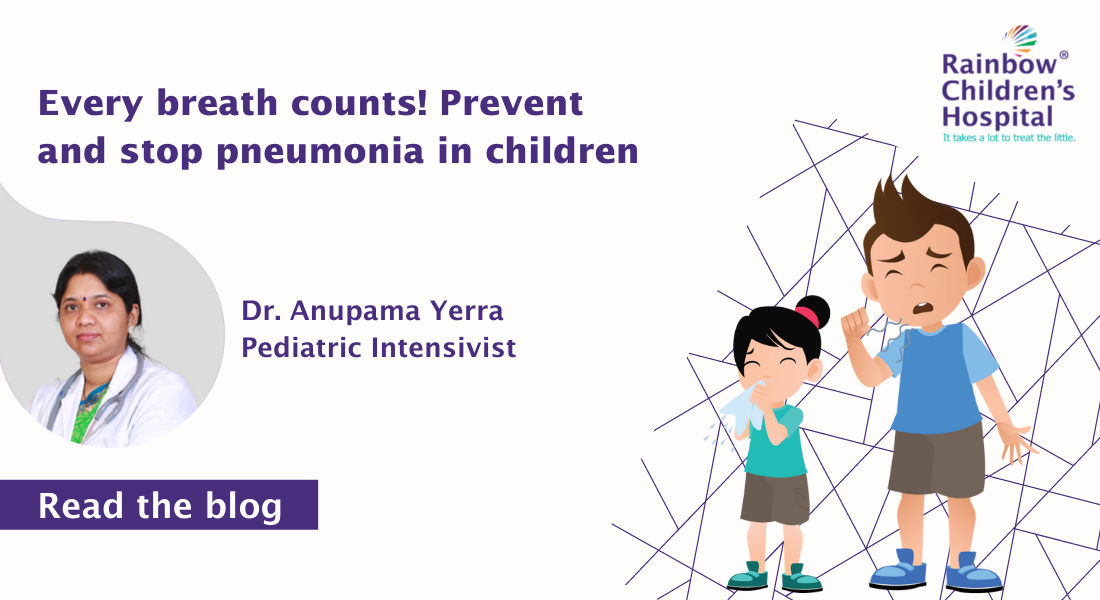Categories
Every breath counts! Prevent and stop pneumonia in children
Oct 26, 2022
Children were hospitalized with us in our Pediatric Intensive Care department with severe lung infection (pneumonia). The older sibling, a 4-year-old boy, was hospitalized with invasive pneumococcal pneumonia (severe lung infection by Pneumococcal pneumonia) requiring high-flow oxygen therapy (HHFNC) and prolonged hospital stay.
Subsequently, the younger sibling, a 2-year-old girl, was hospitalized with similar disease, and she required high flow oxygen (HHFNC), supportive care and surgery VATS (Video-assisted thoracic surgery) and lobectomy for her necrotizing pneumonia (severe lung damage due to pneumonia).
Pneumonia is a form of acute respiratory infection affecting the lungs. Invasive pneumococcal disease is severe pneumococcal infections causing bacteremia (infection in the blood), meningitis (infection of the lying of brain and spinal cord), pneumonia, otitis media (infection of the middle ear) and sinusitis.
How does this infection spread?
People spread pneumococcal bacteria to others through direct contact with respiratory secretions, like saliva or mucus. Many children harbor this bacterium in their nose or throat without causing infection, they are called carriers. These infections are most common in the winter and early spring. Crowding, season and presence of upper respiratory tract infection influence the spread of organism in the family.
Which children are at risk of pneumococcal disease?
Children with chronic lung/kidney and neurological problems
Children with diabetes, with damaged spleen, sickle cell anemia
Children who had cochlear implant, post organ transplant (liver/kidney)
Child with compromised immunity
Children with nephrotic syndrome (kidney problem)
Children with CSF leak
Children less than 2 years
Symptoms and complications in children Children can present with varied symptoms of fever, cough, chills and rigors, headache and stiff neck and difficulty in breathing. There could also present with ear pain, sore throat. One in 12 children with pneumococcal meningitis can have fatal disease and one in 30 children with pneumococcal bacteremia can have fatal disease. Can we prevent this? Pneumonia is the single largest infectious cause of death in children worldwide and it can be prevented with simple interventions. Simple interventions to prevent, protect and treat children with pneumonia are: Routine immunizations, including pertussis, measles, and H influenza Exclusive breastfeeding for first 6 months Safe drinking water, good sanitation and frequent handwashing with soap Good nutrition, especially for children over 6 months of age Improving indoor air quality Recognizing danger signs of pneumonia and seek care quickly Catch-up vaccination
In the recent COVID-19 pandemic, children have missed their vaccination schedule. We can provide catch-up vaccination for children who have missed their pneumococcal vaccine schedule. 1. Child's age is more than 6 months – one year, two doses 4 weeks apart, with a booster dose at 23 months can be provided 2. Children between 12-23 months we can provide two doses 8 weeks apart 3. Children between 24-59 months one dose can be administered Every breath counts, prevent pneumonia in children with simple interventions.
Symptoms and complications in children Children can present with varied symptoms of fever, cough, chills and rigors, headache and stiff neck and difficulty in breathing. There could also present with ear pain, sore throat. One in 12 children with pneumococcal meningitis can have fatal disease and one in 30 children with pneumococcal bacteremia can have fatal disease. Can we prevent this? Pneumonia is the single largest infectious cause of death in children worldwide and it can be prevented with simple interventions. Simple interventions to prevent, protect and treat children with pneumonia are: Routine immunizations, including pertussis, measles, and H influenza Exclusive breastfeeding for first 6 months Safe drinking water, good sanitation and frequent handwashing with soap Good nutrition, especially for children over 6 months of age Improving indoor air quality Recognizing danger signs of pneumonia and seek care quickly Catch-up vaccination
In the recent COVID-19 pandemic, children have missed their vaccination schedule. We can provide catch-up vaccination for children who have missed their pneumococcal vaccine schedule. 1. Child's age is more than 6 months – one year, two doses 4 weeks apart, with a booster dose at 23 months can be provided 2. Children between 12-23 months we can provide two doses 8 weeks apart 3. Children between 24-59 months one dose can be administered Every breath counts, prevent pneumonia in children with simple interventions.











